Miscellany and Snippets
A collection of bits and pieces of local interest that may also be of use to researchers on a particular subject. Not collated in any order, just for dipping into.
Some notable dates on Neath's Timeline

A NEATH POSTCARD PUBLISHER
(by Stephen Rowson)
Collectors of Neath postcards will know of the fine real photographic series of cards published by FW Holloway. The views are numbered and often bear Holloway's address as Windsor Road, Neath. His subjects were scenes along the valley to its head at Glyn Neath and even 'over the top' at Hirwaun. Many of them are street scenes and others are of industrial, railway and river transport interest. Recently, I happened upon a notice of Holloway's tragic death in the Western Mail for 20th August, 1917.

PONY WALBY VIADUCT, GLYNNEATH
Although he was only 58 years old at his death, the newspaper described Frederick William Holloway as already retired and a former newsagent and fancy goods dealer of 52 Lewis Road, Neath.

THE VILLAGE, NEATH ABBEY
He was knocked down and killed the previous Saturday near the Bowen's Arms while cycling between Skewen and Llansamlet. The driver of the car was Doctor John Wilson Williams of Pontypridd but he was exonerated from blame by a jury at the later inquest who decided on a verdict of accidental death. Holloway was the eldest son of Mr John Holloway, a former employee of the Western Mail Ltd and a brother of W. H. Holloway who was on the staff of the Weekly Mail. In October, the newspaper reported that Holloway's will had been proved to the value of £2,565 gross and £1,111 net, all being left to his widow and sole executrix, Esther.

MAIN WHARF, NEATH RIVER
Does anyone know more about Holloway's business and the scope of his publishing? Who was his photographer? Perhaps he used one of the Western Mail photographers where his father and brother worked.
*****************************
THOMAS LLEWELLYN TUCKER
Master Painter and Decorator of Briton Ferry
RAY COLLIER
Still attached to the gable-end of 1 Tucker Street and clearly visible from Neath Road at Cwrt Sart, is the advertising hoarding for Thomas Llewellyn Tucker and Sons, painters, decorators, signwriters and grainers, established in 1895.

Born in Neath in 1876 to Hannah and Joseph Tucker, a boot and shoe maker, on the 1891 census Thomas Llewellyn Tucker is 15 years old and apprenticed as a painter. Having established his own business in 1895, then by 1911 Thomas his wife Sarah, along with their three children, had moved to 1 Tucker Street.
The arrival of the Tucker family in a street bearing their surname was not a coincidence. Three years earlier, the 1908 electoral register has them living at 1 Victoria Place, Briton Ferry, a ‘street’ of five houses, with numbers 2 to 5 occupied by families with the surnames of Thomas, Jarrett, Howells and Daniel. In 1911 those same families are Thomas Llewellyn Tucker’s neighbours in the four remaining houses in Tucker Street. Probably, by a combination of Thomas’ prominent trade sign and his local standing, within a few years Victoria Place had become colloquially known as ‘Tucker Street’ and by the time of the 1911 census the name had been officially adopted.
On the 1939 Register of England and Wales, he is described as a ‘Master Painter and decorator – house, coach and signwriter’.
A member of the Briton Ferry Working Men’s Club and Briton Ferry Constitution Club, Thomas Ll. Tucker was a resident of Tucker Street until his death, aged 85, in April 1962. In his obituary the Neath Guardian noted that on the opening of the Briton Ferry Public Hall in 1911, he had ‘played a big part’ in organising the first arts and crafts exhibition to be held there and was ‘an artist whose works [had] been exhibited in galleries and exhibitions’.1
1. Neath Guardian, 27th April 1962 - p.7.
______________________________________________________________
This is what Alex was doing in 1932

OBITURY OF A RARELY KNOWN LOCAL ARTIST
Neath Guardian - Friday February 10th 1928
DEATH OF LOCAL ARTIST - LATE MR S.P. MELLIN
The death of a local artist occurred at Neath on Saturday morning in the person of Mr Samuel Peploe Mellin, of 8 Harle Street, Neath.
Mr Mellin, who was in this 79th year, at one time owned one of the largest painting and decorating businesses in the town.
He had painted a large number of local scenes that showed outstanding facility with the brush. Included among them were one of the Neath Abbey and a very old view of the Neath Wharf.
About 45 years ago, he was commissioned to paint a portrait of Albert the Prince Consort, from a copy. He was also a very clever pen and ink artist and executed a finely finished portrait of R.A Browning, late gas manager of Neath.
There is a sad story attached to one painting entitled 'A Dutch Village Festival', the original of which hangs in the Brussells Art Gallery. This painting was commenced by Mr Mellin's father, who died while at work on the picture. The work was continued by Mr Mellin, but so laborious was the task entailed that even now it hangs unfinished.
Other portraits are of his wife and one of himself, which was executed with the aid of a mirror.
Years ago the banners of many of the chapels were painted by him.
He was a clever musician and would play almost any instrument. The possessor of a pleasing tenor voice, he was a popular member of the old Neath Harmonic and Dramatic Societies. He belonged to the original Christy Minstrels in the town and took an active part in the Old Volunteers at Neath.
He was an all-round athlete being a good cricketer and a champion on the ice. He played cricket for the old Cadoxton Club and remembered the late W.G Grace playing cricket on the ground, which is now the Victoria Gardens. He would delight to relate how WG was clean bowled by Joe Lovering, one of the best bowlers of his time. He also played with Sir John Llewelyn, who on the occasion offered Joe Lovering a sovereign, which he placed on the wickets. Lovering sent down a demon delivery and pocketed the sovereign.
Mr Mellin was one of the finest figure skaters in Wales and won the Neath championship. He was also a first class shot
He had been up in a balloon and had the exciting experience of being shipwrecked while painting the cabin of a ship.
Mr Mellin was a conservative and had lived nearly all his life in Neath, where he had been in business over 50 years. His wife pre-deceased him 29 years ago. He leaves two children - Mr Jack Mellin of Neath and Mrs Maddocks, with whom he was living at the time of his death.
Note: Samuel Peploe Mellin was an ancestor of the actor comedian Ben Miller. This connection was featured in an episode of ‘Coming Home’ which was filmed partly at the NAS archive and transmitted on 4th December 2015.
From a time many decades before pedestrianisation

Transcribed from the original
Jan’y 19th 1916
To: E.C. Curtis Esq.
Dear Sir
We should be very much obliged if you will kindly place before your committee, our complaint with regards trams and other passenger vehicles stopping in front of our windows.
Even on fine days, our windows facing The Square are frequently rendered unapproachable, while on wet days our lobbies are utilised as waiting rooms and business is seriously interfered with.
We would suggest that such vehicles should stop in front of the Gwyn Hall, where there is plenty of rooms (sic) for waiting passengers and plenty of cover when raining, without interfering with anyone’s business.
Yours faithfully
BW Davies & Co.
G. Paddison.
Notes:
1. EC Curtis was the Town Clerk to Neath Corporation.
2. BW Davies’ premises predates the building of the ‘Burton’s Block(now Holland & Barrett)
3. The Gwyn Hall in those days contained the Council Offices.
4. The route of the Gas Tram traversed The Square from Orchard Street to New Street in front of Davies’ premises.
_____________________________________________________________
This snippet comes via one of our members whose great grandfather who is listed in the 1861 census as landlord of the Cross Keys (and also a tin worker) when the Brunel Dock was opened.
Brecon County Times 1st July 1871
A NICE CHARACTER
Rachel Williams was charged with assaulting Mr John Davies, landlord of the Cross Keys, Briton Ferry. She was also charged with committing wilful damage at the same house. Complainant deposed that the defendant came to his house and broke one of the glasses, she then threw a spittoon at him, and broke that also, after which she attacked him with a chair, injuring his arm, winding up her vagaries by smashing a pane of glass with her fist, shortly after returning and breaking three more in the same manner. Evan Reynolds, master of the steam tug, Pioneer, corroborated the complainant’s statement, but added that he called her a 'bitch' in Welsh. In reply to the Bench, defendant said: - A captain came to look for my husband and I sent for him to the public house. He did not come, so I went down to fetch him out. In my passion, I tried to get him out, and the landlord called me a d---- b----. I then threw the spittoon at him, then he and his wife called me foul names, and I threw the chair, and would have hit him if I could, but he defended himself; the chair only touched his arm; I was determined to get him out, and I’ll keep him from there – law or gaol, or what not! – The Bench after a suitable admonition, fined the defendant 5/- for the assault, or seven days: 4/- for damages, or seven days extra and costs.
Local Poets & Songsmiths?


 William Charles Jones who was from an old Neath family, lived in Alfred Street and was considered a 'CHARACTER'. He served in the RAF during World War 2
William Charles Jones who was from an old Neath family, lived in Alfred Street and was considered a 'CHARACTER'. He served in the RAF during World War 2
FROM A TIME WHEN METERS WERE FAR FROM 'SMART'
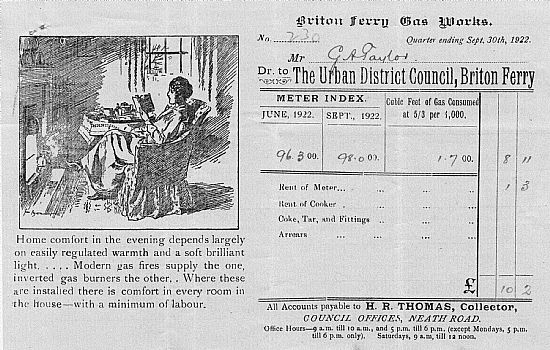

WHEN NEATH WAS AWASH WITH INNS AND PUBS

MISTY WINDOWS? - THEN USE THIS

IT'S REALLY WORTH DOING THE FIELD WORK
JANET L WATKINS
These days most family history research work seems to be done online......but how much 'primitive satisfaction' can be found by actually getting out there with map in hand?
Several years ago I was researching my paternal great grandmother in the Cilcennin area near Aberaeron and followed a lead that her second husband was Jenkin Evans a weaver of 'Pendibyn', Cilcennin.
 After a search along the country lanes, we eventually found a gate displaying the house name 'Pendibyn' - Geronimo! We were dismayed to see a rather large modern bungalow on the site but were warmly greeted by the owner, especially after giving him a brief explanation of why we were peering over his gate.
After a search along the country lanes, we eventually found a gate displaying the house name 'Pendibyn' - Geronimo! We were dismayed to see a rather large modern bungalow on the site but were warmly greeted by the owner, especially after giving him a brief explanation of why we were peering over his gate.
He invited us in and was obviously aware of my old folks from local folk lore. He gave us a tour of the immaculate grounds around his bungalow and eventually (with a grin and a twinkle in his eye) pointed out an ivy-covered ruin on his road-side boundary.........the original cottage and workshop of Jenkin and Hannah Evans, Pendibyn.


Nothing can express my feelings at that moment.

Jenkin & Hannah Evans
__________________________________________________
CHARLES BULLIN
Martyn J Griffiths
I have written previously about the grave of Thomas Bullin, which is to the right of the vicar’s walk from the church at Cadoxton to the road. He was a farmer of tolls, in other words, he leased all the toll gates that he could throughout South Wales and southern England. Members of his family were frequently placed in charge of the various groups of gates and also served as toll-keepers. Another grave in the churchyard at Cadoxton is the resting place of Thomas’ brother, Charles. This grave is on the south side of the church.
 Thomas Bullin leased the Aberystwyth gates from 1836, so his brother Charles was possibly there from that date. He was at the Aberystwyth South gate in 1841 (he also collected fees at the local harbour); in 1851 at Llanarthney and at Swansea Upper (in the Strand) in 1861. The Rebecca Riots lasted from 1839 to about 1843 but whilst his brothers were at the centre of the dispute, Charles Bullin was barely affected at Aberystwyth. Although the government accepted many of the grievances, the collection of road taxes through tolls was not abandoned but continued in a revised form until the late nineteenth century.
Thomas Bullin leased the Aberystwyth gates from 1836, so his brother Charles was possibly there from that date. He was at the Aberystwyth South gate in 1841 (he also collected fees at the local harbour); in 1851 at Llanarthney and at Swansea Upper (in the Strand) in 1861. The Rebecca Riots lasted from 1839 to about 1843 but whilst his brothers were at the centre of the dispute, Charles Bullin was barely affected at Aberystwyth. Although the government accepted many of the grievances, the collection of road taxes through tolls was not abandoned but continued in a revised form until the late nineteenth century.
If you have been to the Folk Museum at St. Fagans then I am sure you will have seen the tollgate. This was originally sited in Aberystwyth South, so there is a direct link with Charles Bullin who is buried in Cadoxton churchyard.


Charles was married at St. John’s Church, Swansea in March 1865. At the time of his burial on 20th April 1870 he was styled 'of Swansea' and his age was given in the register as 51, the newspaper obituary shows him as 56, but was more likely 54. Age is just a number!
______________________________________________
It is fair to surmise that every visitor to Neath would extol the beauty of the ancient Abbey, however some of the writers if these travel guides were not quite so complimentary in their remarks about the rest of the neighbourhood nor its inhabitants;

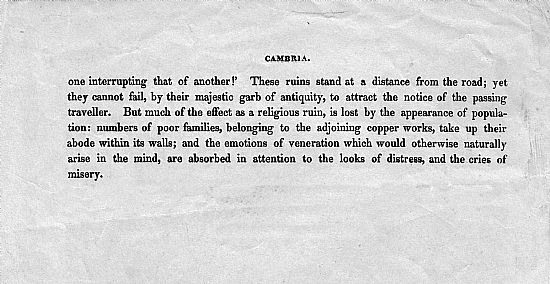
Not only a town of grime but one of crime too!

___________________________________________________
The pages below from an early twentieth century schoolbook were written with a fine steel nib using liquid ink from an inkwell (remember those!). They are 'joined up' handwriting exercises that many today could do with to improve their illegible scrawl. It is also a picture of the morals and attitudes of a bygone age.



___________________________________________________
As the old saying goes: 'Where there's muck - there's brass', but if you were in Carmarthen in 1864 then you had better shift it quick before you lose it all together. It seems they were up to their eyes in it!

Such a Sad Case

Baby Farming is the historical practice of accepting custody of an infant or child in exchange for payment in late-Victorian Era Britain and, less commonly, in Australia and the United States. If the infant was young, this usually included wet-nursing (breast-feeding by a woman not the mother). In many cases a child was placed with such women following an inwanted pregnancy due to effective and available birth control.
The Queens Hotel (latterly The Canterbury Arms) is located at the corner of Orchard Place and Queen Street in Neath.
_________________________________________________________
A 'rare' example of a male manicuring ritual?

Neath Herald - Spring 1980
Micky Budd must have dearly loved his nailfile (maybe as much as the young lady from Hong Kong). No report has been found thats tells of him having been reunited with it. HMS seraph was scrapped on 20th December 1965 at Ward's in Briton Ferry and not Swansea as implied. It would have been like the old saying 'looking for a needle in a haystack'.
____________________________________________________
From the NAS Archive Collection
These days soccer teams are generally transported by the team coach with even the smallest amateur club hiring a conveyance from a local coach operator. Not in 1923, this club took to the train. The itinerary naturally accommodated those of a religious persuation (probably the majority at that time).
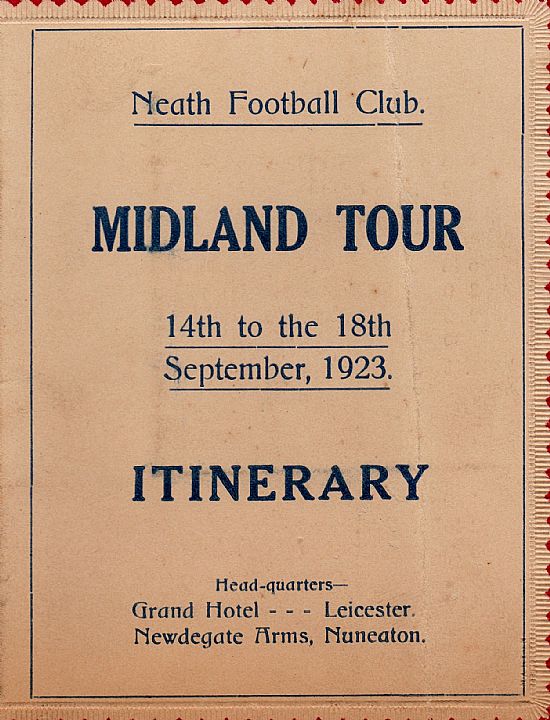
 _______________________________________________
_______________________________________________
Looking through various pieces of ephemera sometimes unearths items long forgotten that remind us of how attitudes and allegiances change with the passing of time. Here is one such item from the time when media communications were not as they are today. Little did people then know about the murdering regime of terror the Russian people were suffering under the despot they were happy to call 'Uncle Joe'.


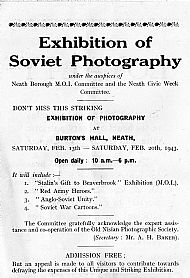
_______________________________________________
A COLLIER'S CLAIM
from the NAS archive

NAS/WHR 2/4a
_______________________________________________
When Briton Ferry Shopped Locally
There was a time when most people in Briton Ferry bought all their goods locally and had local tradesmen to carry out all their repairs. Here's a selection of the businesses in operation in Briton Ferry between 50 and 60 years ago. The choice of grocers was very wide, for example, Bradley's, Dan T Davies, E G McCutcheon, Pegler's, Hill's, the Misses Jones, Shute's and the Co-op. The following are the prices you would have paid for your goods: granulated sugar 2½d (1p) per lb; tea 9d (3½p) per quarter (Mr Bradley sold his own blend at (3p) called 'Wal-Har-Bra'); cask butter 10d (4p) per lb; cheese 10d (4p) per lb; dried fruit 10d (4p) per lb; tinned fruit, medium 10d (4p); Ideal milk, small 3½d (1½p); biscuits 6d (2½p) to 1/- (5p); block salt 2½d (1p); flour 2½d (1p) per lb; Persil, small 31/2d (1½p); Hudson's dish washing powder 1½d (½p).
For supplies of meat there were the following butchers to choose from: W L Davies, Len Poley, Ernie John, D H Lewis, Dickie Rosser, Marshall's and the Co-op. A piece of beef cost 2/3d (11½p); steak 1/1d (6p); suet 5d (2p); giblets 1/-(5p); pork chops 9d (3½p); 121b turkey £1/11/4d (£1.56½p); a piece of lamb 3/5d (17p); bacon 10d (4p) per lb and ham 1/3d (6½p)per lb.
Bakeries included Taylor's, Stockham's and Hawkins'. White bread cost 4½d (2p) large and 2½d (1p) small and a small brown 3½d (1½p). Mr Hawkins was noted for his delicious 'Darren' bread.
Among the tobacconists and confectioners were 'Thomas the Hall', Orville John, Cavalli's, Mrs Edwards, Mr Perrett, Dillwyn's and Mr "Isaac the Blind". A box of matches cost 1d (½p); Player's and Gold Flake cigarettes were 6d (2½p)for 10, Woodbines were 2½d (1p) for 5 and 4d (1½p) for 10.
Newspapers could be purchased from Mr Lewis, Mr Nicholls, Pugsley's or Miss Aubrey, who also sold toys. Another shopkeeper who sold toys was 'Birdie' Lewis. There were many shops which sold clothing, for example, D H Lewis, Morris, 'Top Shop', Wilf Lewis 'The Star', Howell Williams, Mr Howells, M J Thomas, 'Elsie's', Ivor Thomas and W Perrett who was known as 'Billy eleven-three' because so many items in his shop cost eleven pence three-farthings. Like Mr Olive the draper, Mr Perrett would give his customers a free packet of pins instead of a farthing change. A scarf would have cost 5/11d (29½p); 2 pairs of stockings 2/11½d (19½p); a shirt 6/11d (34½p); gloves 5/11d (29½p); a collar 10½d (4p); a coat 28/11d (£1.44½p); a belt 1/-(5p) and a bow-tie 1/6d (7½p). A jersey would set you back 7/9d (38½p) whilst a model hat cost 4/11d (29½p); a nightdress 2/6d (12½p); a frock £1/6/11d (£1.34½p) a petticoat 3/11d (19½p); a pair of knickers 2/- (10p) a vest 2/- (10p) and a gent's coat six guineas. A corset from M J Thomas, Miss Shute or Mrs Ruby Davies cost £2/0/0. For those who didn't like buying 'off the peg', Miss L Davies would make a dress for 4/- (20p) and charge 6d (2p) for silks and buttons. Miss Gladys Williams would make a coat for 6/- (30p) and charge 2d (1p) for the Sylco (thread).
A pair of Women's shoes from Oliver's, Cash's, the Co-op or G W Arnold cost up to 22/9d (£1.13½p) and children's shoes around 12/11d (64½p). Polish to clean them was 2d (1p) or 5d (2p) a tin. When your shoes needed repair, you could take them to Mr Melbourne or Mr Lllewellyn.
Probably many of your household goods would have been bought from J T Edwards. A rug would have cost you 16/1 Id (84p); a pair of curtains 24/6d (£1.22½p) a bedspread 6/6d (32½p); a bakestone 2/11d (14½p) and a bin 5/6d (21½p). Anyone who wanted to build up a collection of 'family silver' could go to Harry Howells, Watchmaker and Jeweller who would sell them a four-piece EPNS tea-set for £3/5/0d (£3.25p).
Electrical goods were supplied by D Richards or J Evans, both of Osterley Street, and you would have been charged 11/- (55p) for an electric fire. Sid Pearson would have sold you a radio so you could keep up with the latest craze. Your pharmaceutical needs would have been met by Miss Trick, Mr Wynn Jones, Miss Eiryl Jeffreys, or the Co-op Chemist.
With regard to repairs to your property, Sid Poles would have put new sashcords and weights in your windows and hung them, and let you have some spare wood for 17/- (85p). If your garden gate needed replacing, Vernon John would have made you a new one and hung it for £1/7/2d (£1.37p). Johns and Hampton would have carried out repairs to your roof, troughing etc. for £1/8/1d (£1.40 ½p) or even built you a new house if you wanted it, as would Lawford Gower and Sons. If the exterior of your house needed painting, T LI. Tucker would have completed the job for £4/5/0d (£4.25p). Your plumbing needs would be met by Tom Davies. If there was death in the family the undertaking might have been done by Saph's (who were also ironmongers and ships chandlers), Sid Poles or Lawford Gower and Son. A tasteful wreath would have been supplied by S W Gilbert. Nurseryman, who also sold plants and delivered fresh vegetables by horse and cart. A wreath would have cost you 10/6d (52½p).
note: the author is unknown at present
_________________________________________________
WHERE WAS THAT HOUSE?
Useful Reference Maps
Researchers frequently enquire about the location of some of the mansions and villas around the district. Two sketches appeared in past NAS Transactions. These have been redrawn and appear below. Whilst they are of a schematic nature and not to scale; they may prove useful in general terms. you will notice that one property remains unlisted. If you know which it is please contact us. Similarly, if anyone would like to undertake the same exercise for other local areas, we would be pleased to receive them for posting here.

 _____________________________________________________________
_____________________________________________________________

Don't mess with the women of Neath!
It is very rare in history to get the views of the working man. It is even rarer to get the opinions of the working woman, so the gem unearthed below may well be unique in the annals of Neath.
To set the scene - the year is 1803. Britain has been at war with the French for 10 years. A tenuous peace (The Peace of Amiens) between the two nations ended on 18th May when the French refused to withdraw from Dutch territory. Napoleon is in the ascendancy and the threat of invasion is very real indeed.
In his book 'British Society and the French Wars 1793-1815' (1979), Clive Emsley writes that the Prime Minister, Henry Addington (1801-1804) had received a letter from the women of Neath requesting that they be allowed;
'to defend ourselves as well as the weaker women and children among us. There are in this town about 200 women who have been used to hard labour all the days of their lives, such as working in coal-pits, on the high roads, tilling the ground etc.. If you would grant us arms, that is light pikes… we do assure you that we could in a short time learn our exercise… I assure you we are not trifling with you, but serious in our proposal.'
____________________________________________________
Only those 'gravely interested' need apply!
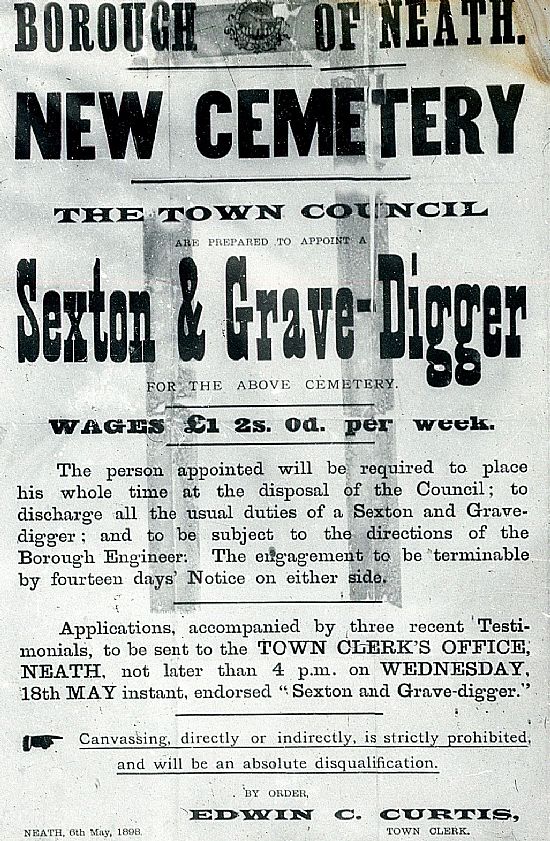
_________________________________________________
Getting 'the needle' in 1890

____________________________________________________
Was it a good night out in Skewen?
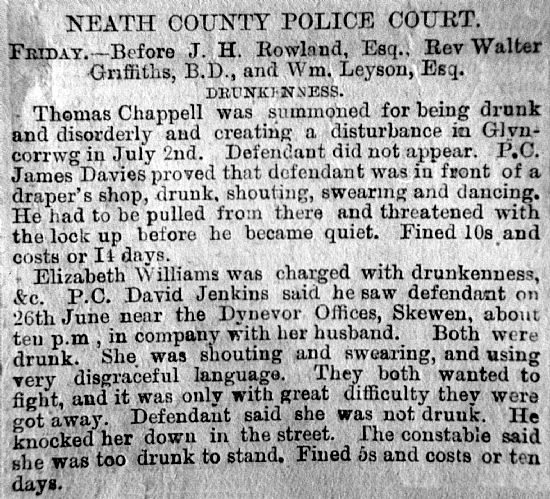
_____________________________________
The Great Fair
Although the town of Neath now regularly 'hosts' speciality events it remains best identified with the Great September Fair. Originally (as with many fairs) this was a 'hiring and horse' fair, but evolved to become a street market and pleasure fair. Even as late as 1936 the horse fair still (just) existed as this cutting from the SWEP of 11th September shows us.

___________________________________________________________________

Herald of Wales - 27th March 1897
___________________
TONNA SHOPS
Like many villages in the district they were once well populated with small shops that catered for the needs of locals without them having to traipse to town. Many shops also allowed goods to be had 'on account' meaning that many families avoided starvation in the middle of the pay week. As mobility increased and shopping habits changed from just the bare essentials these small scale purveyors disappeared. This unedited list, relating, to Tonna is a prime example of how things have changed.
Today there are only two shops left in the Village. In 1935 this is the list of business in Tonna starting at Lock Hill, at the entrance to Tonna where Mr Daniels was the Lock keeper.
1) Mr Lewis the Coal merchant.
2) Mr Mathews. Grocery Shop later to become Gwyn Parry.
3) Mr Johns Radio & Battery charging also the sale of Vindec Bikes
4) Morlais Terrace Mrs Lilly Phillips Sweets and General (Parlour Shop)
5) Mr Mathews Sweets and General (Parlour Shop)
6) Llewellyn Howells a branch of London House Aberdulais Selling Groceries and Hardware, later taken over by J O Hughes
7) Mr J O Hughes General & Groceries this was the site of the Wheat sheaf Public House, the Licence transferred to the Royal Oak
8) Opposite Mr J Hopkins had a Fish and Chip Shop later taken over by Mr Mathews
9) Gerts Mrs Evans Clothes Shop and hardware
10) Mr Jenkin Butcher
11) In the woods opposite a shed used for watch repairing
12) Mr Poley had a sweet shop opposite the School
13) Up Wenallt Rd The Thomas's had a coal business and collected the rubbish (Thomas the coal)
14) Gwyn Parry had a grocers Shop in Wenallt Rd on the way up to the Wenallt Farm which was owned by Mr and Mrs Evans
15) Back to the main Road, the Post Office was next to the School and was kept by the Morgan Sisters.
16) Mrs Bowen kept a Grocery Shop and also the Billiard Hall
17) We are now up to the Whittington Arms.
18) On the corner of Whittington Street Mr and Mrs John kept a Fish and Chip Shop
19) Opposite, Mr Danny Rees had a General Store and was very handy on the repairing of grandfather Clocks
20) Opposite Mr Rees, Mr and Mrs Davies kept a Shoe shop
21) On to the Barley Mow which was pulled down, on this site is the Post office
22) Harry Davies had a Grocery shop
23) Opposite, Mrs Blod Bevan kept a Grocery shop
24) On the corner of New Street Mrs Bell had a Shoe repairing shop shop
25) Also on the this corner Mr David Evans had a yard which contained all that necessary for the building Trade and also an undertaker
26) In New Street we had our own Dentist Mrs Macdumat ably assisted by her husband
27) Further down the road Mr Peter Davies ran Tonna Farm
28) Then up the hill to Mrs Brown shop her father in law being the headmaster of Tonna School
29) We also had our own Bakery in Whittington street Mr D Francis
Unfortunately, we have no idea who the author was.
_______________________________________________
Nothing at all to do with Neath but an humourous newspaper cutting found marking a page in one of the archive documents. The date and source remain unknown at present.

________________________________________________
One of the lesser known local victims of the Titanic sinking.

_________________________________________________
A Train Incident
MR EVAN ROBERTS AND THE SMOKER
Mr Evan Roberts, the revivalist, was in South Wales on Saturday, and was a traveller in the train which left Neath for Cardiff about noon.
Mr Wm. Griffiths, of 8, The Parade, Neath, who knows the revivalist very well, was a passenger in the same compartment and relates the following incident:-
Just as the train was leaving Neath Station a party of young men rushed in, crowding our coach, which was a corridor. Many of them invaded our carriage, a non-smoker, and among the number was a young fellow who had a pipe in his mouth. As he persisted in smoking, an elderly man requested him to desist, and in return was subjected to filthy abuse.
In the corner sat a gentleman busily reading. He remonstrated with the smoker, and proceeding, read him a severe lecture on the evils of drinking and fast living.
By this time passengers from other compartments began to crowd around the door of our coach, and some of them, amused at the stranger's earnestness, began to laugh.
Then it was that the stranger indignantly turned upon them with the remark, "You may laugh and scoff as much as you like, but I am determined to stand for what is right, come what may."
The smoker, the cause of all the trouble, sneeringly remarked, "Get away man - you and your preaching! Only the other day that fellow Evan Roberts was preaching and kicking up a fuss all over the country; but what has come of him now, eh?"
A lady who had hitherto sat silent turned to the smoker with the admonition: "Take care what you say! Think of all the good that Evan Roberts did to many thousands of the likes of you."
As she spoke the stranger rose to his full height and, looking the smoker straight in the face, said: "I would like to know what you have to say about Evan Roberts: here is he standing before you."
The shame faced smoker made no attempt to reply.
Surely the incident should serve to bring home to railway companies the annoyance and indignity to which non-smoking passengers are now too often subjected.
December 1906

